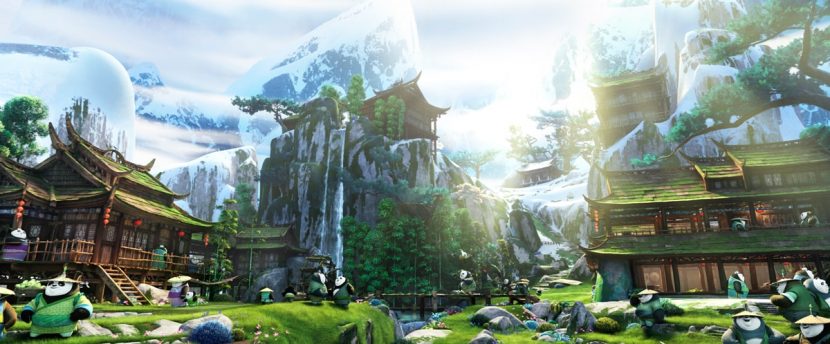Sometimes it’s difficult to comprehend just how much of an animated film has to be built from scratch. And that is to say, all of it. Take DreamWorks Animation’s Kung Fu Panda 3, for example, in which an army of artisans are responsible for crafting everything an audience sees on the screen. That of course involves the characters, the environments and the effects. The effects side of the filmmaking saw DreamWorks draw on years of experienced artistry, R&D and problem solving to help tell this newest tale in the Panda franchise. We talk to key members of the studio’s effects team about specific effects challenges and their solutions.
Going supernatural for Kai
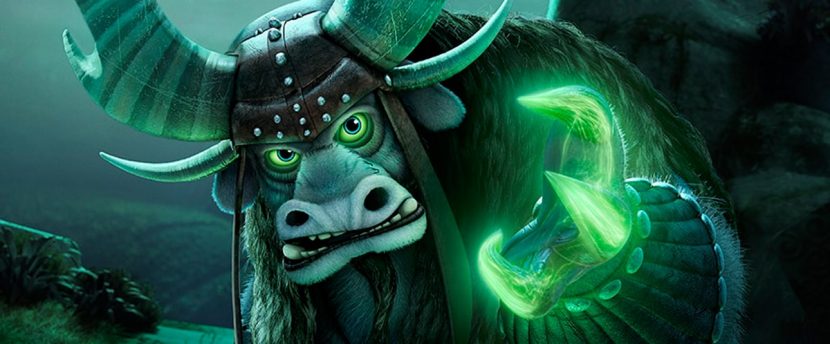
The effect: One of DreamWorks’ first major challenges was to plan for the effects for General Kai (voiced by J.K. Simmons), a spirit warrior with supernatural powers who wreaks havoc throughout the film and ultimately confronts Po (Jack Black). He also has the ability to steal one’s Chi.
The solution: Since Kai is yak-like, with blades and chains amongst his weapons, the studio “developed techniques to handle shaggy long hair and swinging chains with our Character FX team supervised by Nathan Fok,” describes visual effects supervisor Mark Edwards. “In addition, our Head of FX Alex Ongaro and his team refined the various Chi related FX which blend 3d elements with our graphic circle theme.”
The blades and chains were closely tied to Kai’s animation performance using a system developed by Michael Juarez and Jason Weber. “For many shots,” says Edwards, “character animators would control the blade performance and then CFX artists would add the dynamic chain geometry, sometimes cheating multiple sections of chain in to help the simulations and fit the action.”
“After we had done some development work in rigging for Mei Mei’s ribbon (adopted from Viper’s unique control set),” adds Edwards, “Liron Topaz from animation worked with Michael on a test fitting the chain to the ribbon curve. This proved to be invaluable for allowing animation to craft the initial performance for certain shots and then have CFX replace and add extra simulation motion on top.”
DreamWorks developed a specific look for Kai’s Chi stealing power. “The first question we had to answer,” says FX Lead Matt Titus, was, ‘What does Chi look like in Kung Fu Panda 3?’ and then, ‘What does it look like for Kai to steal it?’ To figure those questions out we went through many different iterations and ideas. We have a playlist of 50+ takes we tried. Eventually we found a look that was the right fit for this film and something everyone loved.”
Crafting Jade warriors
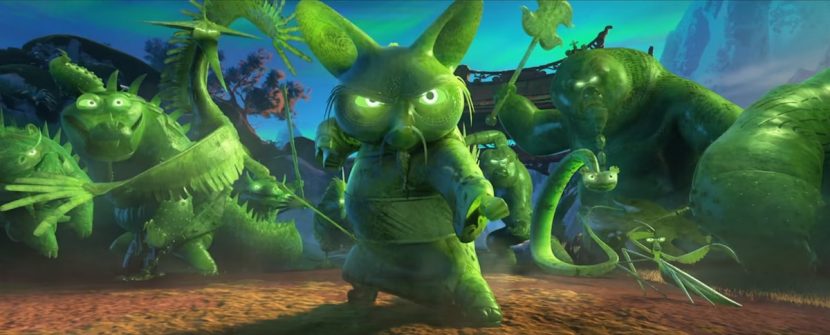 The effect: Kai controls a legion of Jade Warriors, or Jade Zombies, who take on Po and the Furious Five. When Kai steals Chi from Kung Fu masters, those characters are also transformed into jade – into ‘Jombies’. Crafted in jade form, the characters needed to exhibit strong kung fu skills but retain the appropriate gem look.
The effect: Kai controls a legion of Jade Warriors, or Jade Zombies, who take on Po and the Furious Five. When Kai steals Chi from Kung Fu masters, those characters are also transformed into jade – into ‘Jombies’. Crafted in jade form, the characters needed to exhibit strong kung fu skills but retain the appropriate gem look.
The solution: “We worked across all departments to try to make sure our Jade Zombies maintained a range of motion needed for the kung fu action sequences, but didn’t fall into the ‘gummi’ look or feel,” outlines Edwards.
“This started with surfacing adding the beautiful translucent jade qualities and the stylized etchings displaced into the surface to show off a more complex material. Animation developed a quick pose style for their motion and we avoided any kind of realism to their clothing, only adding held pose adjustments to better show off silhouettes. Lighting added additional backlighting wherever possible to show off their translucency which also added to them feeling like more magical creatures.”
The transformations into Jombies required special attention. These transformations were, according to Titus, “started in animation with the team doing an overall scaling on the characters and adding 2d draw overs on the animation movies. Once the shots were approved in animation, the scaling was removed from the characters before they moved down the pipeline.”
“In Fx,” continues Titus, “we would work off the approved animation to keep the same feel and timing. There was a lot of communication and back and forth between animation, Fx, lightings and Cfx. We used OpenVdb and old fashion compositing tricks to blend the transition from the lit Jade character into the Fx elements. The idea for the ‘Jombie’ transformations came later, so it was a modification of the Chi stealing system that Wes Chilton did a great job of tweaking to fit the new idea.”
Destroying a palace
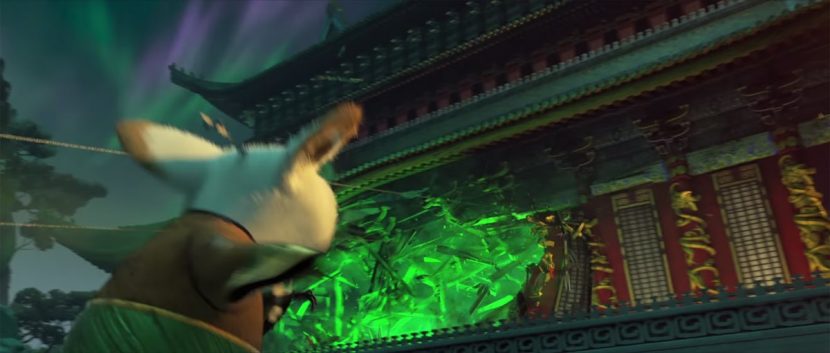 The effect: Kai destroys the Jade Palace in a spectacular sequence involving several Jombies – something that turned out to be among the largest destruction work DreamWorks has ever completed.
The effect: Kai destroys the Jade Palace in a spectacular sequence involving several Jombies – something that turned out to be among the largest destruction work DreamWorks has ever completed.
The solution: Intricate modeling of the Palace and surrounds was required, with DreamWorks then approaching the destruction simulation with new simulation techniques.
“The exterior of the palace alone is made up of over 20 different assets,” says FX Lead Jeff Budsberg, “each with an incredible amount of model complexity – every tile, ornate detail, etc. For simulation, we realized we needed a completely new technique. Unlike stone, wood bends prior to breaking, and it fractures in a distinct manner. We developed a method (called Rumble) of simulating flexible materials, presented at SIGGRAPH 2014, which performs orders of magnitude faster than existing solutions. As our fractures are geometrically difficult, we also proposed a decomposition scheme built on OpenVDB that is robust to concave features, holes, and self-intersecting geometry.
The exterior palace destruction involved four main rigid body simulations, not including secondary and tertiary elements like debris, grit, and dust. “In those four simulations,” outlines Budsberg, “the number of fractured pieces is 6,837, the dynamic rigid bodies involved is 216,989, and constraints between bodies is 1.98 Million.”
The approach differed to previous destruction DreamWorks had tackled. On the first Kung Fu Panda, a standalone CSG-based cutter had been employed. But on this third film, a CSG solution inside Houdini was realized by Mihai Alden, as FX Lead Jason Mayer explains: “This implementation adaptively re-tessellates the resulting geometry, giving us a significant improvement over the native boolean cookie based operations. The intersection and difference operations allowed for fast seamless cuts. The union operation allowed modeling to have looser restrictions when generating geometry that needed to be fractured. The FX artist could union water tight geometry with a series of these CSG operations, allowing for logical art directed groupings of building material. These groupings reduced the need for complicated constraint networks, improving sim time while still retaining visual structural elements upon simulation.
Awakening the spirit realm
The effect: Kung Fu Panda 3 takes place both within the natural wold and the spirit realm. In this spirit world, the look and feel was much more graphic and stylized.
The solution: DreamWorks applied different design rules and effects in the spirit realm based on art department development.
“Production Designer Ramone Zibach and the art department started from a story perspective in imagining that Kai’s presence has been corrupting the tranquility of the Spirit Realm for those 500 years,” states Edwards, “so that helped us in production to think about how that world might interact with itself and the characters.”
Some of the distinct rules for this world in an FX sense were no fine impact dust hits, only shattered graphic rock shapes. “An early look dev test informed surfacing, lighting and matte painting about what elements were important to maintain the graphic quality, such as broad color and art directed texture quality,” says Edwards. “In many cases, restricting the influence of bounce lighting and heavily tinting elements in compositing allowed us to control the focus of the shots, and having all the AoV channels in Nuke was crucial.”
“Matte painting did a great job enhancing the space with subtle animating shapes and flexible color falloff and glow elements,” adds Edwards. “One unique task for our final layout department was adding motion to normally static set dressed elements, and that added an extra level of detail to the environment.”
When balanced is finally restored to the spirit realm, Oogway’s peach tree is restored and along with it a reflective plane of Chi energy. “The art from Art Director Max Boas for this sequence was stunning so we absolutely had to capture that look on the production side,” notes Edwards. “CG Supervisor Igor Lodeiro and his lighting team did an amazing job balancing the traditional CG elements with heavy 2d treatments to craft a unique look true to the artwork. The graphic Chi rings in the sky were a technical challenge tasked to Adam Ely and his matte painting team; procedural animation with noise and timing controls drove the overall elements which were then treated further and a representation in 3d space handed off to lighting for their Nuke based reflection setup.”
Staff power: Master Oogway
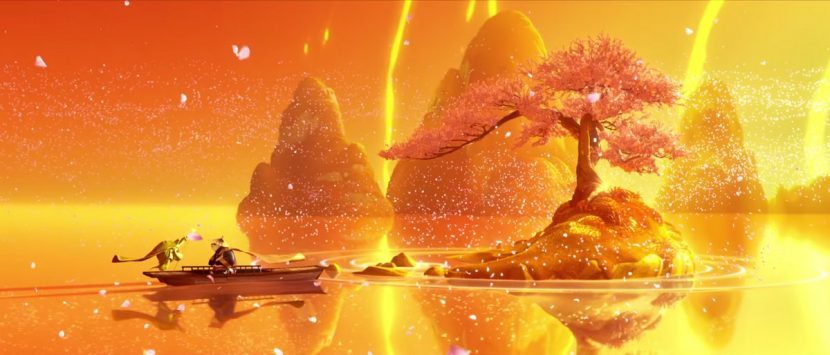 The effect: Grand Master Oogway demonstrates his true prowess – and powers – in the film care of his magical staff.
The effect: Grand Master Oogway demonstrates his true prowess – and powers – in the film care of his magical staff.
The solution: Several animated effects solutions were required for Oogway’s powers, including 2D-like animated shapes, particles and procedural approaches for some petal and portal effects.
“Oogway first uses his staff in the opening of the film during the spirit battle with Kai,” discusses Mayer. “It is a mystical conduit he uses to ‘draw’ calligraphy shapes which he launches at Kai. Significant work went into the design of the letters Oogway used to make sure they would be accurate for our Chinese audiences. Character Animation was able to draw-over the 3d animations to provide a guide placeholder for FX artist Baptiste Van Opstal, who developed the effect. There was some back and forth between FX and animation to make sure Oogway’s motions were in the right place and with enough follow through to draw the trail which was made up mostly of curves and particle simulations.”
Oogway also crafts a yin yang symbol in a similar fashion to use as a giant shield which was made up of similar curves and particulate energy. “Kai spectacularly destroys the shield with a pair of giant colliding rocks,” says Mayer, “causing an explosion and shock wave that rips through the surrounding rock islands which was all animated by Alex Timchenko.”
Oogway’s staff is also used as a tool to direct Chi energy into specific shapes and forces. “Once Po has defeated Kai in the spirit realm,” explains FX Lead Carl Hooper, “he is reunited with Oogway who bestows upon him the Legendary Staff. Po, having received this symbol of achieving Inner Peace, uses it to summon Chi in an attempt to return to the mortal realm. Po scribes the iconic yin yang on the surface of the Chi water he is floating above which ignites a cascade of graceful curves and particles that quickly expand out to fill the entire screen. This effect was realized by Zach Glynn based on the Chi writing effects developed by Baptiste Van Opstal. “
A further power of the staff turns out to be the ability to summon surrounding ambient peach petals that collect into directed streams and form a spherical portal that engulfs Po to transport him back to the mortal realm. “This was accomplished with a combination of simulated and procedural points following animated guide curves,” says Hooper. “The resulting velocities were analyzed and used to drive procedural deformation of the petals stamped to the points. Petal surfaces received full deformation when perpendicular to the velocity vector. This deformation diminished as the petal’s orientation aligned with the velocity direction. The deformation was also attenuated by the speed of the petals and random variation was added to help increase the organic read of the effect. This same technique was used to reveal Po once he appeared back in the mortal realm and for all the ambient petals in the spirit realm.”
It takes a village to build a village
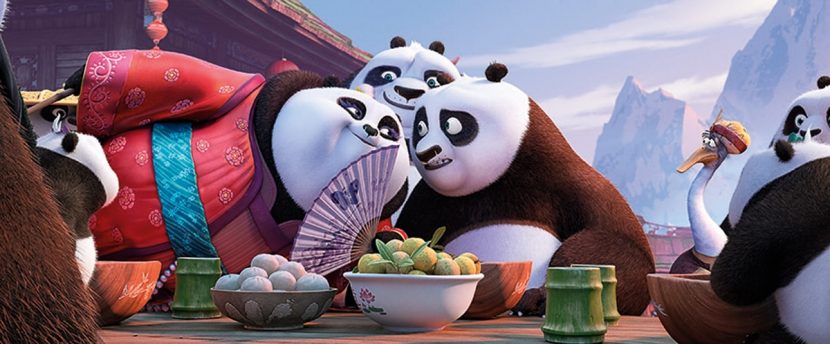 The effect: A picturesque and idyllic setting, the panda village featured numerous effects challenges, from grass to snow, water and a magical petal animation.
The effect: A picturesque and idyllic setting, the panda village featured numerous effects challenges, from grass to snow, water and a magical petal animation.
The solution: Custom water sims, volumetric snow and a system for the petal and portal effects made the village a reality.
“The panda village was unique in that it had some distinct climates that FX had to accommodate, from grass,snow, and water interaction to artistically driven magical petal animation,” details FX Lead Louis Flores. “FX artist Michael Losure created custom water simulations for the waterfalls and each section of the river that flows through the village, in which the pandas would interact with in the film. FX artists Scott Cegielski and Zach Glynn also created volumetric snow using OpenVDB to simulate a believable winter environment in which characters and giant snowballs could reside.”
The magical petal animation effects were crafted via a system developed by Carl Hooper; it was also used by KC Ong to drive the initial creation of the portal effect, to depict the transportation back to the spirit realm, in the village (as described above). “The portal effect created by Steve Wood and Can Yuksel was used early on in the film,” says Flores, “but had to be completely re-imagined during production to accommodate the tone and feel of the village, and it was a very collaborative process between the Art, FX, and Lighting departments to create the final effect that sends Po and Kai back into the spirit realm for their final battle.
The character of mist and fog
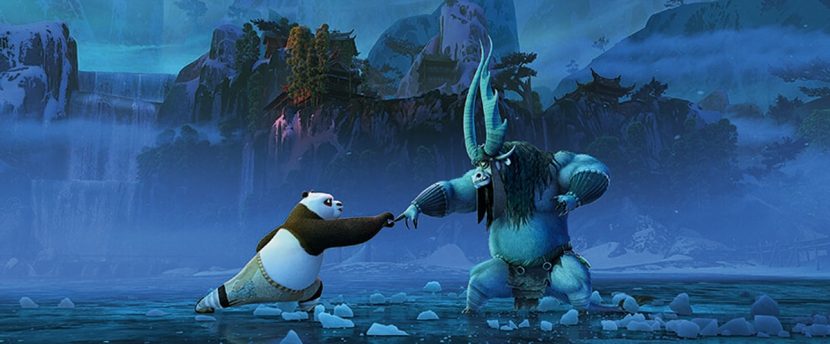
The effect: Throughout the film, areas of mist and fog help reveal locations visited by the characters and aid in selling scale to the landscapes.
The solution: DreamWorks Animation drew on previous extensive R&D in this area, plus work the studio had with OpenVDB volumes rendered in Mantra with Z-depth passes composited in Nuke, along with a new preview tool.
“OpenVDB has become an integral part of our workflow at the studio,” says Titus. “We use it for everything from mist and fog to smoke, fire, snow, geometry manipulation, etc. We have continued to build on our work from previous shows. A big push for us recently has been optimization. The toolset we are using today is so much faster that it is hard to imagine how we used the original tools. Ken Museth and Mihai Alden are amazing and keep making everything faster and easier to use.”
A new preview tool called Amorphous aided in creating these atmospheric effects, as Titus explains: “Mark Matthews wrote an OpenGL VDB previewer for Houdini, Maya and our lighting package. It allows us to see 95% of what we will get out of our final render in realtime while we are doing our sims. It allowed us to dial in most of the settings for the mist without ever launching a render.”
One change DreamWorks also made on Kung Fu Panda 3 was to push more of its volume rendering to the lighting department. “Historically,” notes Titus, “FX has rendered and composited all of their elements, but we found it really beneficial in some cases to have lighting own the final renders for simple FX volumes so there were less chef’s in the kitchen at the end. On the more difficult and large scale volumes like the panda village reveal we kept the rendering in FX where we could leverage our past knowledge of rendering volumes using Mantra. The panda village reveal as well as the villagers and dad reveal were very art driven moments. We needed to dissipate the mist much faster than you would ever see in real life. We did many iterations to find the right balance of the timing and look for those shots.”


